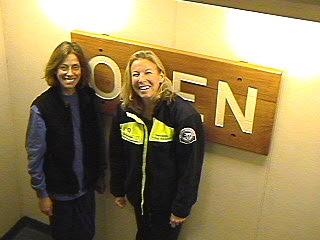
|
|
15 July, 2001
To the Deep, Rough Water
Sunday, 15 July 2001
Hej! (Hello!)
Life on Board
The ship has an amazing video collection and library on the first deck.
There are many recently released videos like Space Cowboys, Being John
Malkovitch, O Brother Where Art Thou?, and Crouching Tiger, Hidden Dragon.
There are also older videos like Shaft. These videos are the regular
English versions with Swedish subtitles. All of the Scandinavians speak
English so I guess they can choose how they want to understand the movie.
There is a movie or two playing almost every night, although sometimes it
is a strictly Swedish movie. One of my first nights onboard, I heard they
were playing Crouching Tiger, Hidden Dragon. I was really excited because
I hadn't seen that yet. I went into the Library Room and took a seat as
the film opened . . . in Chinese with Swedish subtitles! I stayed to watch
it anyway, seeing if I could understand the storyline just watching the
expressions and tone of voice. Interesting experience.
Where Are We Now?
We are steaming to an open water station off of the shallower shelf around
Spitzbergen. It is cloudy and the seas are getting rough again. I hope
our VIPs don't get seasick. Present coordinates are about 79o46' N and 7
o06' E. Our second batch of new scientists arrived from Longyearben and
our VIPs and camera crew departed in the SuperPuma helicopter. I hope they
enjoyed their stay!
Scientists at Work
We were steaming west all day and were supposed to arrive on station about
2 pm in the deep water to the west of Svalbard in the Greenland Sea. The
deep water has different biology than the shelf water, without influence
from the fresher water coming off of the land. We plan to lower a small
device called a fluorometer into the water to a depth of 100 m. It
measures the amount of chlorophyll in the water as it passes through and
sends the information up the wire to a computer. This tells the scientists
how much plankton is in the water at every depth. They then decide which
depths they want to get water samples from, based on the "biomass" at each
level. Next, they tell the sampling rosette (CTD) operating team which
depths they would like samples from and they will program the Nansen
bottles to open at the specified depths.
Unfortunately, we were headed into a storm and the station was postponed to
6 pm because the swell was getting worse. At 5:30, it was still too rough
to put any instruments over the side so the station was postponed to
midnight. It was completely foggy with a visibility of about 100-200 m and
heavy seas. Being a Sunday, we still were required to dress up for dinner,
especially since we had new scientists onboard although we decided to go on
standby for the station to start. Even if it stays too rough to lower the
CTD, they decided to take surface samples if possible. A meeting is set
for 10:30 pm on the bridge to plan.
I'll go to bed but wait for a knock on the door at any time. And set my
alarm for 2:45 am regardless of station for my liquid argon duty.
Vi ses! (See you later!)
From Deck 4 on the Icebreaker Oden, somewhere west of Spitzbergen,
Dena Rosenberger

Dr. Patricia Matrai and I on the Oden. I thought her daughter, 7-year-old Sara, would appreciate a picture of her mom!
Contact the TEA in the field at
.
If you cannot connect through your browser, copy the
TEA's e-mail address in the "To:" line of
your favorite e-mail package.
|
